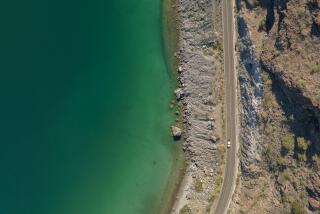Following the Flamingos in Yucatan
- Share via
RIO LAGARTOS, Mexico — It’s impossible to sneak up on a bird. Especially this huge flock of long-legged flamingos with loud “kachooga” sounds emanating from our open launch as it crossed the peaceful estuary.
Every time it happened--just as the old boat approached another flock--200 to 300 deep-pink birds rose from the water, long black-tipped wings flapped, S-curved necks straightened and they were off to a distant shore.
In every direction, on each shore of numerous sand spits and bars, was a pink haze. Flock upon flock--close enough to tantalize, but not close enough to see the bent beak, spindly knees or to use a camera.
That didn’t stop Luis, the guide and kachooga-boat captain. He was dauntless and just kept the little launch puffing across the water. He obviously knew where he was going.
At some instinctual signal Luis cut off the motor and with a deep sigh the old wooden hull settled silently into the water while hundreds of flapping wings took off, painting a pink-and-black streak across the sky.
Part of the Landscape
“Momentito, “ Luis whispered. Sure enough, within 15 minutes the quiet boat and three occupants had become part of the landscape. The birds didn’t come aboard to pose, but at least they didn’t fly farther away. Instead, they went about their constant business of feeding.
This all takes place just outside the small town of Rio Lagartos, a little more than 160 miles from Merida in Mexico’s Yucatan. This small fishing village is known for colonies of flamingos that return each year to reproduce.
In April, May and June literally thousands of pink and cerise flamingos fill the sky as they approach the shallow estuaries and immediately begin to build nests. In smaller (but still impressive) numbers, resident flocks spend the year at Rio Lagartos.
There are six species of flamingos around the world. The American flamingo nests at Rio Lagartos and throughout most of the West Indies. This bird stands five feet tall, with legs 30 inches long and a wingspan of five feet; surprisingly it only weighs about seven pounds. In Spanish the word flamingo means flaming, which aptly describes the color of these water birds.
It gathers food by turning its head upside down, submerging its soft, leathery, bent beak. Comb-like hairs strain out tiny shellfish, insect larvae and algae. These fine organisms are scrambled to the bottom surface when the mud is stirred up by the bird’s stomping webbed feet.
Ravenous Chicks
The flamingo builds its nest of mud in the shape of a cone, the egg lies in a hollow on top, and the whole thing stands about a foot high. Nurturing is done by both parents from the month-long incubation period of the egg to feeding the ravenous chicks.
At hatching, flamingos are white and fuzzy, and at three months the black feathers along their wings begin to grow. By November the babies are beginning to take on their adult pink coloring.
The shallow lagoons and canals near Rio Lagartos wind for miles in and around small islets and sand bars, an ideal place for bird watching. Look for plover, white egret, heron, cormorant, pelicans and the star of Lagartos, the flamingo.
While winding through the estuaries, you’ll see flocks of the pink birds covering a white beach or standing in the shallow water one-legged in large groups. The combination of colors--blue sky, white sand, green water and pink birds--is an effect you’ll not want to rush. The beaches are often tinted a soft coral, covered with silky feathers of flamingos.
The locals are protective of their most famous asset. During the reproductive season, April, May and June, visitors are advised not to disturb birds standing guard over their mud nests. The sounds of outsiders causes the timid birds to rise in flight. Often, the ensuing panic and flapping of wings destroys the fragile eggs.
The rest of the year, it’s an easy matter to get close with a hired boat and guide. From November to March there aren’t as many birds, but still enough (hundreds) to make the trip worthwhile.
Bring your binoculars, camera and plenty of film--you won’t find a corner drugstore (or even a corner) to buy camera supplies in this wilderness area.
The town of Rio Lagartos is an amazing small community. Like the birds, people build their homes in swampy water that submerges a good part of the coast.
Rio Lagartos (meaning lizard river) at one time was host to numerous crocodilians, but over the years they were almost hunted out. Unless you set up camp in a mangrove-lined swamp, the only crocs you’re likely to see are two caiman kept in a fenced mud-wallow on the beach near the Hotel Nefertiti.
The main industry in Rio Lagartos is fishing, not tourism. Locals also work 16 kilometers east at the Las Coloradas salt factory (in operation since the days of Mayas). Most of the employees of the factory are Mayan descendants.
You seldom see more than 10 or 15 people on the estuaries at a time, and most of the time you see none. The absence of buildings, traffic and air pollution is why the large numbers of birds still return each year. It follows then that accommodations for visitors are limited.
The one hotel, the only multistoried structure in town, is on the waterfront. The Nefertiti provides the bare essentials: food, bed and shelter. Anyone with a “sterile” fetish, or who needs extravagant surroundings or deluxe extras better not check in at the Nefertiti. All other adventurers are welcome. Rooms average $20-$25 for two.
The Nefertiti offers some package deals to take you to the estuaries, which are about 25 kilometers from town.
You have a choice of boat or van, full day or half, all moderately priced ($5-$15 per person).
For most visitors these escorted trips are enough. But if you want more time to take pictures or just to contemplate nature’s extravaganza, you may hire a private guide and boat at the hotel. Bargain and settle financial arrangements, length of trip and destination before shaking hands on the deal.
Bring protection from the sun, a lunch and water if you plan a full day on the estuary; most of the boats are open launches and it gets very hot.
For those traveling by car, it’s 100 miles from Merida to Valladolid and another 64 miles to Rio Lagartos. Some travelers use Valladolid as a base because it has a choice of hotels. Others feel it’s best to overnight in Rio Lagartos to get an early start in the estuaries.
Another option to see flamingos is Celestun, another habitat on the Gulf of Mexico, a one-hour drive from Merida. However, most of Celestun’s flamingos migrate to Rio Lagartos during nesting season.
Predators of the flamingo include man, and have for centuries. While only a few still eat the bird and its eggs, history relates that as far back as the days of the Romans flamingo tongues were served as a delicacy at feasts.
How nice that Rio Lagartos flamingos enjoy an undisturbed existence in a peaceful, remote part of the world.
More to Read
Sign up for Essential California
The most important California stories and recommendations in your inbox every morning.
You may occasionally receive promotional content from the Los Angeles Times.










